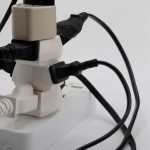Last Updated on 11 months by Francis
Welcome to this discussion on whether laptops emit EMF (Electromagnetic Fields) or not. There has been a growing concern about the health effects of exposure to EMF radiation from electronic devices such as laptops. In this conversation, we will explore the potential health risks associated with laptop EMF, and discuss ways to reduce exposure.
Understanding EMF
Electromagnetic fields (EMF) are invisible fields of energy that are present everywhere in the environment. They are caused by the movement of electrically charged particles and can be found in sources like power lines, electrical appliances, and electronic devices. The strength of an EMF depends on the strength of the electrical current and the distance from the source. Some people are concerned about the potential health effects of exposure to EMF.
The Link Between EMF and Health
There is ongoing research into the potential health effects of EMF exposure. Some studies have suggested that long-term exposure to high levels of EMF may be linked to an increased risk of cancer, changes in brain activity, and other health problems. However, the evidence is not conclusive, and many experts believe that the risk is low. the World Health Organization (WHO) has classified EMF as “possibly carcinogenic” but notes that more research is needed to fully understand the risks.
Key takeaway: Laptops do emit EMF, but the level of EMF is generally considered to be low and not harmful to human health. However, some people may want to take steps to reduce their exposure, such as keeping the laptop away from the body, using a shield or barrier, turning off the laptop when not in use, or using wired connections instead of wireless. The FCC sets limits on the amount of EMF that electronic devices can emit to protect public health, and the SAR limit for laptops is 1.6 W/kg, which is well below harmful levels.
Yes, laptops do emit EMF. Like all electronic devices, laptops generate EMF from their electrical components. The strength of the EMF depends on the strength of the electrical current and the distance from the device. However, the level of EMF emitted by laptops is generally considered to be low and not harmful to human health. The Federal Communications Commission (FCC) sets limits on the amount of EMF that electronic devices can emit to protect public health.
One key takeaway from this text is that laptops do emit EMF, but the level is generally considered to be low and not harmful to human health. However, for those who are still concerned about exposure, there are several ways to reduce it, including keeping the laptop away from the body, using a shield or barrier (with caution), turning off the laptop when not in use, and using wired connections instead of wireless. While ongoing research explores the potential health effects of EMF, the evidence is not yet conclusive, and the World Health Organization notes that more research is needed to fully understand the risks.
How to Reduce EMF Exposure
Although the risk of harm from EMF emitted by laptops is considered low, some people may still want to take steps to reduce their exposure. There are several ways to do this, including:
-
Keeping the laptop away from the body: The closer the laptop is to the body, the higher the level of EMF exposure. It is recommended to keep the laptop on a desk or table and use a wireless keyboard and mouse to operate it.
-
Using a shield or barrier: Some people use shielding materials, such as EMF-blocking fabrics, to reduce their exposure to EMF. However, the effectiveness of these materials is not proven, and they may interfere with the laptop’s performance.
-
Turning off the laptop when not in use: Turning off the laptop when not in use can reduce the amount of EMF it emits.
How Laptops Generate EMF
Laptops generate EMF from their electrical components, such as the battery, hard drive, and wireless card. The strength of the EMF depends on the strength of the electrical current and the distance from the device. When the laptop is turned on, it emits EMF, which can be detected by specialized equipment.
Most laptops use wireless technology to connect to the internet and other devices. This technology generates radiofrequency (RF) radiation, which is a type of EMF. The RF radiation is used to transmit data between the laptop and other devices, such as a Wi-Fi router. The strength of the RF radiation depends on the distance between the laptop and the router, as well as the power of the router.
Key takeaway: Laptops emit electromagnetic fields (EMF) from their electrical components, including the battery, hard drive, and wireless card. While some studies suggest that long-term exposure to high levels of EMF may be linked to health problems, the level of EMF emitted by laptops is generally considered to be low and not harmful to human health. To reduce exposure, it is recommended to keep the laptop away from the body, use a shield or barrier, turn off the laptop when not in use, and use wired connections instead of wireless whenever possible.
Do Laptops Emit Harmful Levels of EMF?
The level of EMF emitted by laptops is generally considered to be low and not harmful to human health. The Federal Communications Commission (FCC) sets limits on the amount of EMF that electronic devices can emit to protect public health. The FCC requires that all electronic devices sold in the United States meet these limits.
The limit for laptops is called the Specific Absorption Rate (SAR), which is a measure of the amount of RF radiation absorbed by the body. The SAR limit for laptops is 1.6 watts per kilogram (W/kg), which is well below levels that have been shown to cause harm in studies.
Key Takeaway: Laptops emit EMF, but the level of exposure is generally considered low and not harmful to human health. To reduce exposure, it is recommended to keep the laptop away from the body, use shielding materials cautiously, turn off the laptop when not in use, and use wired connections instead of wireless. The Federal Communications Commission sets limits on the amount of EMF that electronic devices can emit to protect public health.
How to Reduce EMF Exposure from Laptops
Keeping the laptop away from the body
The closer the laptop is to the body, the higher the level of EMF exposure. It is recommended to keep the laptop on a desk or table and use a wireless keyboard and mouse to operate it. This will reduce the amount of time the laptop is in direct contact with the body.
Using a shield or barrier
Some people use shielding materials, such as EMF-blocking fabrics, to reduce their exposure to EMF. However, the effectiveness of these materials is not proven, and they may interfere with the laptop’s performance. It is important to use reputable products and follow the manufacturer’s instructions when using shielding materials.
Turning off the laptop when not in use
Turning off the laptop when not in use can reduce the amount of EMF it emits. This is a simple and effective way to reduce exposure.
Using wired connections instead of wireless
Using wired connections instead of wireless can reduce the amount of RF radiation emitted by laptops. For example, connecting the laptop to the internet with an Ethernet cable instead of using Wi-Fi can reduce exposure to RF radiation.
FAQs for the topic: Do Laptops Emit EMF
What is EMF?
EMF stands for Electromagnetic field. Electromagnetic fields exist everywhere around us – they can be produced by electrical devices and electrical power systems. EMF is made up of two types of fields: electric fields and magnetic fields. At low frequencies, electric and magnetic fields are almost inseparable and hence, are often referred to as EMF.
Yes, laptops emit EMF. Actually, most electronic devices emit EMF, and laptops are no exception. Laptops use electricity to function which produces EMF. As the device works, different parts like the keyboard, screen, hard-drive, processor, and the wifi module all emit different levels of electromagnetic radiation. However, the amount of radiation emitted from laptops is small in comparison to other devices such as microwaves or cell phones.
Is EMF from laptops harmful?
The health impact of EMF is still under research; however, there is growing concern that over-exposure to electromagnetic radiation can be harmful. Though laptops emit lower amounts of EMF, long-term exposure can still have an impact. The high level of exposure to EMF can cause symptoms such as fatigue, headaches, and nausea. Furthermore, recent studies reveal that exposure to high levels of EMF for an extended period could lead to the development of cancer.
How can I reduce my exposure to EMF from my laptop?
To reduce exposure to EMF from laptops, you may choose to use an external keyboard and mouse for convenience. Additionally, you can use a laptop radiation shield or anti-radiation laptop sticker. It is advisable to minimize the use of your laptop while charging as electric fields can reach extremely high levels while charging. You can also adjust your Wi-Fi settings to reduce your computer’s exposure to wireless radiation.
How else can I ensure safety when using my laptop?
Always remember to take breaks when working on your laptop for an extended period. Moreover, the distance between oneself and the laptop does matter when it comes to EMF exposure. Ensure that you maintain a distance of at least one foot between yourself and your laptop whenever possible. Finally, turn off your laptop when not in use.


.jpg)




